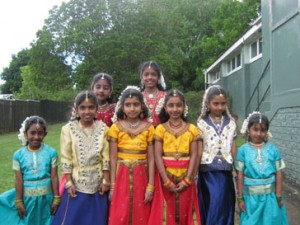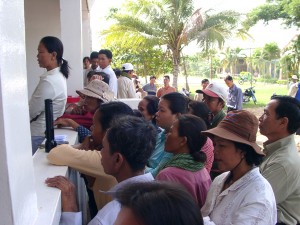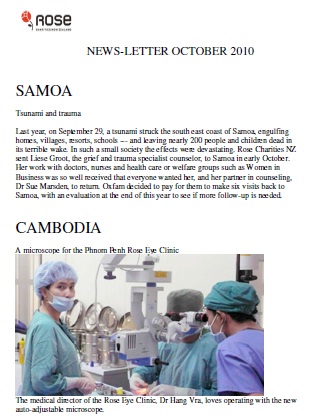These are Tamil children who have been supported by Poonga, the Tamil Community Education Group. Rose Charities NZ has given Poonga an annual donation for several years.
In the lower photo they are dancing outside the Auckland Town Hall, during the Diwali celebrations in October. 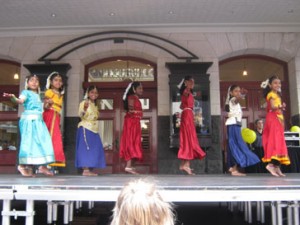
Poonga Tamil Community Education Group pupils dance for Divali
2010 NZ AGM Highlights
The 2010 Rose Charities NZ was held on 2 October at Pip and Bill’s place on Waiheke Island. The following notes are a summary of the the main points emerging from the meeting.
- We have a new trustee, nominated by Mike Webber, Heather Richardson. Heather is a specialist theatre nurse who has worked a lot with Mike at Wanganui Hospital. (The microscope that went to Cambodia in March this year was her “baby” for 10 years.) She is also a Rotarian. She lives in Marton. She has had experience conducting nursing training for ophthalmology in Fiji. We are lucky to have her join our team.
- We are applying for accreditation with MFAT / NZ AID for NZ contestable NGO funds.
- CAMBODIA: Planning for the year ahead: A very valuable ($100,00 new) Phaco machine has been donated to Rose for the Cambodian clinic from St Georges Southern Cross Hospital in Christchurch. It will be packed and crated by Agility Logistics, as happened with the microscope sent in March this year, and will be sent up to Phnom Penh early next year. It is proposed to ask Dr Basant Sharma of Nepal, who uses exactly the same instrument at the Lumbini Eye Institute, to go to PP to oversee the installation and training of staff. Rose will need to pay for this. Trustee John Veale may also be going up to Cambodia with the machine.
- Note: since the AGM another machine has been donated to use from Wanganui. Mike is very excited about this, as it can be used for field work and early detection of problems that lead to blindness. It too will be packed and shipped up and of course Rose will be paying for this.
- Mike Webber and John Veale are discussing a future laser machine for the PP clinic, which Rose would have to purchase.
- Future plans for possible projects in Cambodia would involve outreach work, to reach people in the country. Possibly a new clinic might be established; a van for outreach work, to get doctors and nurses to eye camps, might be considered (about $US 10,000 would have to be raised.)
- NEPAL: Trish Gribben is going to visit Basant Sharma at the Lumbini Eye Institute around November 22, and will report back after that. Basant, who came to New Zealand for three weeks two years ago, says that outreach work has been on hold while the political situation is very unstable. He will be taking Trish to a village where an outreach clinic could be a good possibility. The group I am travelling with is being led by Dr John McKinnon, a retired ophthalmologist who was the first doctor in Ed Hillary’s first hospital in Nepal, 45 years ago.
- PACIFIC: Mike Webber reported that eye care in the Pacific is well covered by the Fred Hollows Foundation, so it is not a priority for Rose.
- Rose sent a grief and trauma counsellor to Samoa after the tsunami, Liese Groot-Alberts. Her work was so well received that she was asked to return six times this year, and OXFAM have supported her to do that. However, a need for PALLIATIVE care in Samoa has been identified and Liese has been asked to conduct training workshops for doctors and nurses to get this started. Rose is very keen to help her do that. We understand that there is a huge burden placed on families when a terminally ill patient is sent to NZ for treatment and dies here. The emotional and financial cost to families can be life changing.
- In New Zealand we have confirmed donations to two new refugee support groups in Auckland and Christchurch, to help with family reunification; a women’s group within the Tamil community in Auckland; and the Champion Centre which gives early intervention for children with multiple disabilities.
Inspiration in Cambodia !
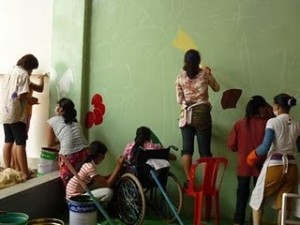 When Trish Gribben and Jane Midgley (Rose Charities NZ chairperson and treasurer) were in Phnom Penh, Cambodia, for the June meeting of Rose people from around the world, they visited Rose Australia’s rehabilitation project, run by physiotherapist Joanna (will, surname please). She was busy supervising the construction of a space attached to a hospital for post-operative physio—a concept almost entirely unheard of in Cambodia. The big room-to-be had no roof, lots of rubble and bamboo. NOW LOOK AT IT ON JOANNA’S BLOG:
When Trish Gribben and Jane Midgley (Rose Charities NZ chairperson and treasurer) were in Phnom Penh, Cambodia, for the June meeting of Rose people from around the world, they visited Rose Australia’s rehabilitation project, run by physiotherapist Joanna (will, surname please). She was busy supervising the construction of a space attached to a hospital for post-operative physio—a concept almost entirely unheard of in Cambodia. The big room-to-be had no roof, lots of rubble and bamboo. NOW LOOK AT IT ON JOANNA’S BLOG:
We also met Chan Chea, a young woman who had not moved from her wooden cot since an illness struck her five years before. Thanks to Joanna’s physio programme over the last four months, Chan Chea could WALK to receive a certificate at the opening of the brightly-painted centre.
Trish Gribben says: “This is one of the best and most moving things I have EVER seen!”
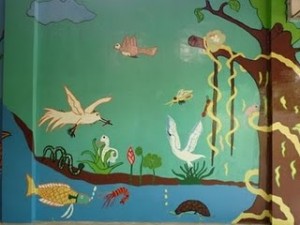
The Light in Their Eyes
Trish Gribben visits an eye clinic in Cambodia with ties to New Zealand where sight has been restored for thousands of patients.
It is Monday morning at the Rose Eye Clinic in Phnom Penh, Cambodia. The first of maybe 100 patients for the day have arrived and are sitting patiently lined up on long stools, in the shade of a few straggly mango trees. Incense wisps up from a little temple nearby. None of the patients has an appointment. Many a mother, with a few possessions tied in a cloth bundle on her back, is brought to the clinic by a young child, perhaps a 10-year-old son, holding a bamboo stick between them to lead the way because mother is blind. They may have spent two days to get to the Rose clinic, walking or taking a bus.
After assessment and cataract surgery that very same day, mother’s sight miraculously restored, the pair set off side by side. When they return to their village the seeing-eye son can return to school for the first time since his mother’s sight faded completely two years before. This is a typical story from Cambodia. It also involves three Good Kiwi Blokes (GKBs); hands that have restored sight to thousands of blind eyes; a looting; a mix of microscopes, money and mates.
The three GKBs are all mates: John Veal, optometrist from Christchurch, Dr David Sabiston, ophthalmologist from Hawkes Bay and Mike Webber, OMNZ, optometrist from Whanganui. Together, over the last eight years, these GKBs, as trustees of Rose Charities NZ, have worked with a local Cambodian doctor and nurses to set up an eye clinic in Phnom Penh for the very poorest people. The three GKBs, between them, have made 14 trips to Cambodia since 2002. Every time they go they have taken up microscopes and equipment generously donated by the optometry community in New Zealand.
“The donating of good quality second hand instruments from eye surgeons and wholesalers in New Zealand has been way beyond expectations,” says Mike Webber. “I get a real buzz from being at the eye clinic in Phnom Penh. So little effort and money by our standards goes such a long way, for such a lot of people. They have absolutely nothing. We can improve their lives without interfering with local customs or communities. Why not just do it?”
In Cambodia there are 16 ophthalmologists for 14 million people. Eye problems are so commonly left unchecked that people go blind when a simple procedure could have saved their sight. (In the Auckland phone book there are 16 ophthalmologists within less than a kilometre on the medical strip along Remuera Road.)
The medical director of the Phnom Penh eye clinic is Dr Hang Vra, a Cambodian who trained as a doctor in Moscow. On holiday in the Ukraine as a student he met his wife, Natalie, who is now the senior nurse at the clinic.
Dr Vra, who is completing post-graduate ophthalmology training paid for through Rose Charities NZ, has what David Sabiston calls “some of the most beautiful surgical hands I have seen in my career.” In the last eight years Dr Vra and his team have seen more than 88,500 patients at the clinic; nearly 18,000 have received surgery and the others have been fitted with glasses. Last year nearly 2500 people had surgery.
In March this year Mike Webber was as excited as a boy with a new i-Gadget when he went to set up the most sophisticated microscope donated to the clinic so far — a $65,000 Moller-Wedel operating microscope cast-off from the Whanganui Health Board. Thanks to Agility Logistics’ benign freight bill and two of Webber’s mates in Wanganui paying the airfares for him and a technician, Neville Wood, to travel to Phnom Penh to assemble the instrument, the cost to Rose Charity was only $350. There are plenty of GKBs out there.
Within a day of the new microscope arriving Dr Vra had mastered the auto-adjustable instrument. He is beaming about his job becoming easier and more precise. But this story is not just about expertise and equipment. It is about lives given light in a country that has endured the horrors of the dark era of the Khmer Rouge when hardly a doctor was left alive
after the purges of all educated people in the 1970s and ‘80s.
I visited the Rose clinic in Phnom Penh recently, as chairperson of Rose Charities NZ. To see the transformation when a life is changed in the instant when bandages are removed after a cataract operation is magical.
On my first visit, there was one old lady sitting stoically behind her dark glasses; not a smile, not a muscle moved. Her daughter, dressed in her best street wear, Miss Kitty yellow and white pyjamas, did her best to fan her mother in the heat. Next day this old lady (probably years younger than me) sat like a stone while her bandages were taken off. Suddenly, she grabbed my hand and hugged and hugged it. Her smile was as wide as it could be. For the first time in a decade she could see. Her world looked bright.
The clinic has a turbulent story, typical of many in Cambodia. S**t has definitely hit the fan. In 2002 the entire Rose clinic was looted — chairs, operating table, microscopes, clock, stock and barrels of patient records. But Cambodians have had to cope with far greater horrors than that, of course, and in the Buddhist spirit of acceptance and resilience, Dr Vra and Nurse Natalie, simply kept going. They acted like heroes, comforting the patients as they kept turning up. Rose New Zealand followed their lead and renewed efforts to get equipment and professional support for Dr Vra as often as possible. That eye clinic is now regarded as doing the best eye surgery in Cambodia. It is not in any way “competing” with a Fred Hollows clinic—the two Fred Hollows clinics in Cambodia are deep in the countryside.
The clinic is still so basic that Dr Vra’s current ‘wishlist’ reads like
this:
- materials for a cupboard for brooms, buckets and mops so the blind patients don’t trip over them.
- a swing door into an operating room so that sterile hands do not have to wrestle with the door handle.
- a sterilising room moved closer to the surgery room, to reduce the risk of infections, always a crucial factor with eye operations.
- a second-hand washing/drying machine, to help out in the rainy season.
- a mended ceiling in the recovery “ward” where patients rest immediately after surgery on woven mats on iron beds, patiently attended by a wife, husband, daughter, son.
Food is brought to them from the stalls lining the dusty street nearby. A towel or cotton scarf is used as a fan. No bathroom exits; a cool sponge-down in the sticky heat is not an option. No bathroom is on the wish-list—such luxury is unthinkable.
Dame Silvia Cartwright, New Zealand’s former Governor General who is currently in Phnom Penh as a member of the international war crimes tribunal there, is a patron of Rose Charities NZ. She has visited the eye clinic and been greatly impressed at what the Kiwi-Cambodian co-operative effort has achieved.
“I know that all around the world the same help is being given to people in need,” said Dame Silvia, “but I know Cambodia best and this country has so much to offer. Its people are clever, welcoming and generous. Equally, it lacks some of the most fundamental health care of any country in the world. The Cambodian people deserve our support in improving their skills and knowledge. It is a privilege to see highly skilled New Zealanders such as Mike Webber come regularly to work with local specialist ophthalmologists so Cambodian people can have the best care possible.”
Rose Charities is an network of “helping hands” that operates out of 9 countries — Canada, USA, New Zealand, Australia, Vietnam, UK, Sri Lanka, Cambodia, Malaysia.
It has current projects from Madagascar, where it runs a school, to Nepal, where women volunteer health workers are being trained to identify and prevent eye problems, to Sri Lanka where children orphaned in the 2004 tsunami are being given on-going help.
Rose likes to keep things simple. Kindness is its raison d’etre. It was founded by a doctor, William Grut, whose mother, Rothes Grut (nee Neville) was a New Zealander. Will was born in Malaysia, educated partly in Christchurch and now lives in Vancouver. There is an umbrella Rose International Council but there are no grand plans for super-sizing up. At an international gathering in Phnom Penh for Rose recently, the treasurer’s report was brief: “Zero dollars IN. Zero dollars OUT. The council has no money, no budget.” Individual Rose groups raise money for the projects they support by a variety of means ranging from cooking lessons to fashion shows or theatre nights. Volunteers provide all the support, with practically no money being spent on administration.
As well as its on-going commitment to the Cambodian eye clinic, Rose Charities NZ has plans for medical-aid projects in Nepal and the Pacific. It has helped a trauma and grief counsellor, Liese Groot, to work with medical professionals in the Philippines, Malaysia and Samoa and is giving support within the refugee community here.
–In the set-up days of the fledgling Rose Eye Clinic in Phnom Penh, a weight was needed to apply post-operative pressure to patients’ eyes. Nothing, no instrument, was on hand. One of the doctors looked around the make-shift structure (as it was then). On the floor were some old bolts. Quickly he picked them up, wrapped bandages around them and rested them on the patient’s eyes. Job done.
Now a beautifully-balanced weight is used at the clinic. It was designed by Dr Basant Sharma, an ophthalmologist from Nepal, who is currently vice-chairman of Rose International and who has worked alongside the Cambodian medical team in Phnom Penh to offer his expertise. Rose NZ brought Dr Sharma to New Zealand two years ago for his own professional development.
— There was a time when Dr Will Grut was in the Cambodian countryside for an eye camp with Dr Vra. Patients were lined up for surgery in a thatched hut. Down came a deluge of rain, dripping through a hole in the roof. “That will be the end of surgery today,” thought Dr Grut. “But no. Someone took a syringe, siphoned some petrol out of a nearby vehicle, injected it in to a polyfoam material and we all watched while it foamed up. It was used to patch the hole in the roof – and the surgery went on.”

